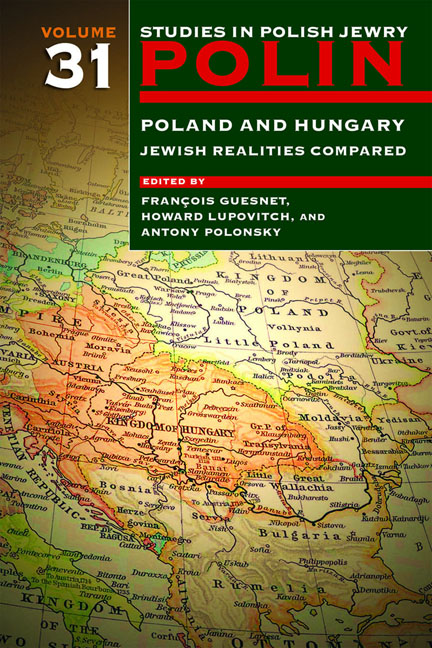Book contents
- Frontmatter
- Dedication
- Editors and Advisers
- Preface
- Polin
- Polin: Studies in Polish Jewry
- Contents
- Note on Place Names
- Note on Transliteration
- Part I POLAND AND HUNGARY: JEWISH REALITIES COMPARED
- JEWISH ACCULTURATION AND INTEGRATION
- JEWISH RELIGIOUS LIFE
- JEWS IN POPULAR CULTURE
- THE INTERWAR YEARS
- THE HOLOCAUST AND ITS AFTERMATH
- PERSONAL REFLECTIONS
- Part II NEW VIEWS
- Part III OBITUARIES
- Notes on the Contributors
- Index
The Magnate–Jewish Symbiosis: Hungarian and Polish Variations on A Theme
- Frontmatter
- Dedication
- Editors and Advisers
- Preface
- Polin
- Polin: Studies in Polish Jewry
- Contents
- Note on Place Names
- Note on Transliteration
- Part I POLAND AND HUNGARY: JEWISH REALITIES COMPARED
- JEWISH ACCULTURATION AND INTEGRATION
- JEWISH RELIGIOUS LIFE
- JEWS IN POPULAR CULTURE
- THE INTERWAR YEARS
- THE HOLOCAUST AND ITS AFTERMATH
- PERSONAL REFLECTIONS
- Part II NEW VIEWS
- Part III OBITUARIES
- Notes on the Contributors
- Index
Summary
WRITING IN 1927, Hungarian Jewish author Lajos Hatvany described, in his autobiographical novel Gentlemen and People, the angst of Hermann Bondy over whether or not the Blaus, a noble couple who had been invited to his wedding, would show up:
Would Gusztáv Blau come? Would he bring his wife? Certainly the Blaus had accepted the invitation on paper and were present at the ceremony in the synagogue… . But these superior people had not deigned to mingle with the crowds who had rushed to greet the bridal pair. They had hurried away… . But Bondy's thoughts were interrupted by the opening of the door and the entrance of little Gusztáv Blau in person. In he stumbled, smiling and clean-shaven, with his side whiskers and his diplomat's face… . All the guests were then presented in turn to the Blaus, who stood in the centre of the hall like royalty. The panting ladies from the provinces … were lost in admiration of Frau Blau's gigantic ear-rings and her collar of pearls the size of hazelnuts. And that the wealthy banker's wife should be so kind with it all—a real lady! … Indeed, you could see from her whole manner that she had been brought up in Pest… . Now the Bondys would be able to say they had been admitted to the leading circles in Pest.
This comic image of Jews fawning over the arrival and attention of a noble and his wife is a common theme in Jewish literature, no less than in the actual relationship between Jews and nobles. Particularly in Poland and Hungary, which had the highest proportion of nobles in Europe, noble patronage was a critical part of Jewish life.
Unusual in the above story, though, is the fact that the noble family are Jewish. This underscores a central difference between noble–Jewish relations in Hungary and in Poland. In numerous European countries, and especially in Poland and Hungary, Jews forged a stable working relationship with nobles and, especially, with the magnates with whom they did business. In Hungary, though, this relationship progressed further than anywhere else, epitomized by the ennoblement of more than 300 Jewish families during the dual monarchy from 1867 to the end of the First World War.
- Type
- Chapter
- Information
- Polin: Studies in Polish Jewry Volume 31Poland and Hungary: Jewish Realities Compared, pp. 31 - 40Publisher: Liverpool University PressPrint publication year: 2018



